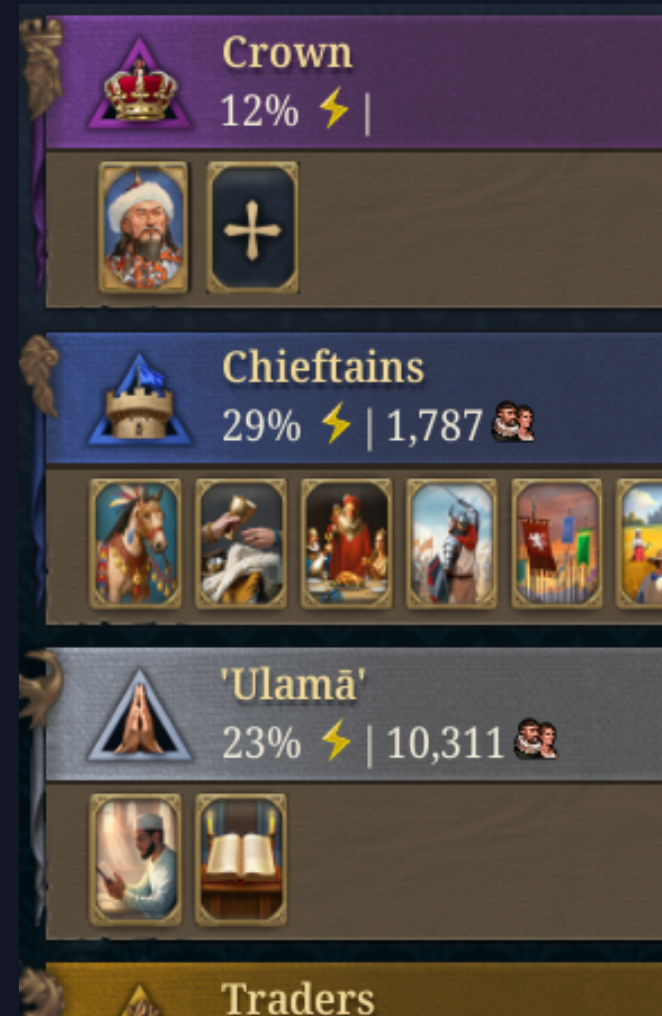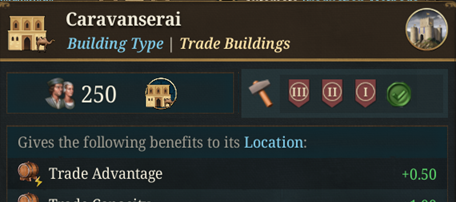Hello, and welcome one more Tuesday to Tinto Flavour, the happy days in which we take a look at the flavour content of Europa Universalis V!
Today, we will be taking a look at the Golden Horde! Being the most important Steppe Horde in 1337, it has a good mix of both unique and generic content. Let’s start, without further ado:



As usual, please consider any UI, 2D, and 3D art as WIP.
Steppe Hordes are a type of Army-Based Country, and it has some specificities:

As you see, it starts with some Reforms and Privileges:





Here you have some of the unique advances of the Golden Horde, as usual:





The Mongol Steppe Hordes have access to two unique units:


These illustrations were recently added to the unit tooltip; the first is the one for the East Asian graphical culture for Age of Traditions Horsemen, while the other is the generic one for supply units.
And also a couple of unique buildings:


The Golden Horde has access to a unique mechanic to portray its relationship with the Russian Principalities, the Tatar Yoke, which is an International Organization:



As you see, there are three statutes, the Tatar-Overlord (the Golden Horde), the Grand Prince of Vladimir (which in 1337 is Muscovy), and the regular members:


The Grand Prince of Vladimir collects the tribute from the regular members, and sends it to the Tatar-Overlord:



…Or not, because each member has a special section in the country budget to pay more or less tribute, and then, the Grand Prince of Vladimir also chooses how much of that goes to their Tatar-Overlord:

If any member, including the Grand Prince, pays less than 50% of the capacity, it will get a development malus, portraying the small-scale raids conducted by the Horde to put the princes in line. If the budget is over 50%, the members will get a bonus on their diplomats, and the Grand Prince, on its Prestige.
Finally, there are a couple of additional actions in the IO. One allows any member of the Tatar Yoke to declare war to break it, while the other allows any member to request the Tatar-Overlord to become the new Grand Prince of Vladimir:



Let’s now move into the narrative content. The most important piece of content is the Horde Civil War, a disaster that can appear if the horde unity dips too low. Once it starts, a pretender rebellion will be formed.




There are some events that can happen while the disaster is active, usually with not the best of outcomes:





Neighboring countries may take this opportunity to attack…
Once the rebel progress of the pretender reaches 100%, an event will fire, giving the option to either accept their demands or make it escalate into a full civil war.


It is treason then…
If victorious in the civil war, the pretender will be put in his place, but as long as the disaster is still active, another one will soon rise again:


Only when there are no more rebellions or civil wars active, and both stability and horde unity have been restored, will the disaster finally end:

… And much more, but that’s all for today! Tomorrow, in Tinto Talks, we will talk about the mechanics of the Islamic religion!
And also remember, you can wishlist Europa Universalis V now! Cheers!
Today, we will be taking a look at the Golden Horde! Being the most important Steppe Horde in 1337, it has a good mix of both unique and generic content. Let’s start, without further ado:



As usual, please consider any UI, 2D, and 3D art as WIP.
Steppe Hordes are a type of Army-Based Country, and it has some specificities:

As you see, it starts with some Reforms and Privileges:





Here you have some of the unique advances of the Golden Horde, as usual:




The Mongol Steppe Hordes have access to two unique units:


These illustrations were recently added to the unit tooltip; the first is the one for the East Asian graphical culture for Age of Traditions Horsemen, while the other is the generic one for supply units.
And also a couple of unique buildings:


The Golden Horde has access to a unique mechanic to portray its relationship with the Russian Principalities, the Tatar Yoke, which is an International Organization:



As you see, there are three statutes, the Tatar-Overlord (the Golden Horde), the Grand Prince of Vladimir (which in 1337 is Muscovy), and the regular members:


The Grand Prince of Vladimir collects the tribute from the regular members, and sends it to the Tatar-Overlord:



…Or not, because each member has a special section in the country budget to pay more or less tribute, and then, the Grand Prince of Vladimir also chooses how much of that goes to their Tatar-Overlord:

If any member, including the Grand Prince, pays less than 50% of the capacity, it will get a development malus, portraying the small-scale raids conducted by the Horde to put the princes in line. If the budget is over 50%, the members will get a bonus on their diplomats, and the Grand Prince, on its Prestige.
Finally, there are a couple of additional actions in the IO. One allows any member of the Tatar Yoke to declare war to break it, while the other allows any member to request the Tatar-Overlord to become the new Grand Prince of Vladimir:



Let’s now move into the narrative content. The most important piece of content is the Horde Civil War, a disaster that can appear if the horde unity dips too low. Once it starts, a pretender rebellion will be formed.




There are some events that can happen while the disaster is active, usually with not the best of outcomes:





Neighboring countries may take this opportunity to attack…
Once the rebel progress of the pretender reaches 100%, an event will fire, giving the option to either accept their demands or make it escalate into a full civil war.


It is treason then…
If victorious in the civil war, the pretender will be put in his place, but as long as the disaster is still active, another one will soon rise again:


Only when there are no more rebellions or civil wars active, and both stability and horde unity have been restored, will the disaster finally end:

… And much more, but that’s all for today! Tomorrow, in Tinto Talks, we will talk about the mechanics of the Islamic religion!
And also remember, you can wishlist Europa Universalis V now! Cheers!





